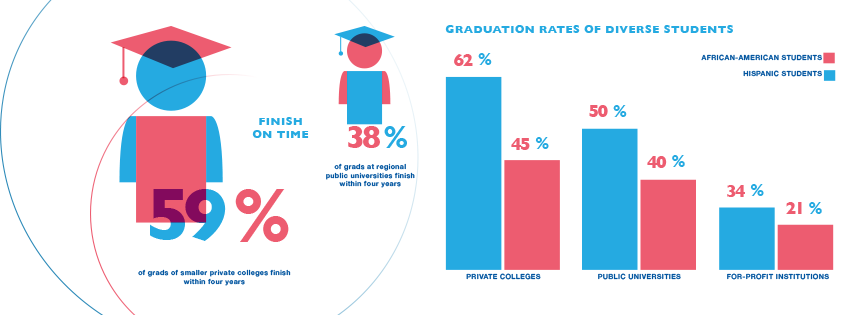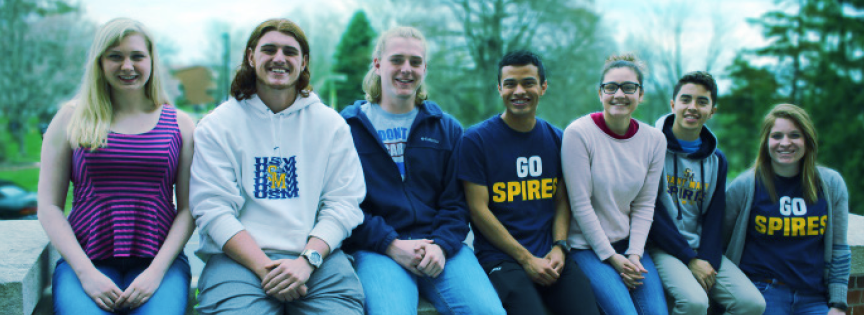Your Major… A Minor Impact on Real-World Success?
A major is one of the first ways students classify themselves in college. Some hope to pursue graduate school, while others are already counting down the days until they land the “real world job.” Some pick a major that sounds “fun.” Others declare a major Mom picked for herself at the tender age of seven.
Regardless of how students come to their decision and what they settled on, it’s theirs and (at the time) it was right.
Or was it?
College students tend to believe their “real world” success will depend on how they answer the question: “What are you majoring in?” They justify their answer by an appeal to utility and support it with statistics and facts, like these, from the Bureau of Labor Statistics:
“Over the past 12 months, health care added 470,000 jobs.”
“The future of the economy is in STEM. That’s where the jobs of tomorrow will be.”
“Business and financial operations occupations are projected to grow 8 percent from 2014 to 2024.”
Higher education, especially the liberal arts university, faces a powerful assumption that occupational majors reign as the superior path to long-term success and security. Though dismissing employment opportunities following graduation would be foolish, forgetting the importance of the liberal arts would be just as silly.
Defining: Liberal Arts
An approach to learning that empowers individuals and prepares them to deal with complexity, diversity, and change. It provides students with broad knowledge of the wider world (e.g. science, culture, and society) as well as in-depth study in a specific area of interest. A liberal education helps students develop a sense of social responsibility, as well as strong and transferable intellectual and practical skills such as communication, analytical and problem-solving skills, and a demonstrated ability to apply knowledge and skills in real-world settings.
The opposite of liberal arts? If there was an antonym, it would be an applied professional program — meaning concentrated on just the tasks and skills of a working environment (including business, education, engineering, law, medicine, or accounting). Liberal arts refers to a combination of disciplines in the following:
Discipline — Course of Study
- Humanities — Arts, English, Foreign Languages, History, Philosophy
- Social Sciences — Anthropology, Communication, Geography, Political Science, Sociology
- Sciences — Biology, Chemistry, Biochemistry, Physics
- Math (yes, math!) — Algebra, Calculus
Very few entry-level jobs require specialized undergraduate study. And graduate schools follow this same story—med schools don’t demand biology degrees, and majoring in poli sci doesn’t guarantee consideration from a law school.
Across the board, employers and graduate schools want adaptability, flexibility, and critical thought.
Alumni—let the brilliant words of John Henry Newman in “The Uses of Knowledge” resurface: “I have said that all branches of knowledge are connected together, because the subject-matter of knowledge is intimately united in itself, as being the acts and works of the Creator.”
Faced with the rising costs of higher education, critics argue the “extra” courses required at liberal arts institutions add unnecessary debt — yet countless success stories and convincing facts dismantle that fallacy.
So, do majors really even matter?
An overwhelming majority of employers (93 percent) believe a college graduate’s ability to think critically, communicate clearly, and solve complex problems are more important than his or her undergraduate major. And law schools continue to report their top students come from math, classics, and literature.
Academic majors merely reflect interest and skills, not intelligence, aptitude, or the promise of success. Too often students are paralyzed by the question, “What’s your major?” — thinking of its long-term implications and all the stereotypes that coincide.
The liberal arts create breadth of knowledge — which 80 percent of employers say they want. The calculus class an art major loathes or the drawing class an accounting major despises are a part of a much bigger picture called “life.”
Saint Mary isn’t alone in our push for the liberal arts.
USM is one of 700 member colleges in the Council of Independent Colleges (CIC) supporting a national advocacy program promoting the understanding of the liberal arts and the effectiveness of independent higher education called “Power of Liberal Arts.” The member colleges sum up their advantages with four bullets:
- A liberal arts education prepares students for personal and professional success.
- Diverse students enroll in and excel at small private colleges.
- Private colleges keep the price of college low and return-on-investment high.
- Private colleges offer top-quality teaching, small classes, and engaging activities.
USM Liberal Arts Success Stories
Kate Greene, C’01, Chemistry.
 An anomaly to right- or left-brain dominance theory, Kate loves both science and writing—and excels in both. An acclaimed essayist, journalist, and poet, she’s a former laser physicist whose work has appeared in the Harvard Review, Slate, Discover, Aeon, Pacific Standard, WIRED, The Economist, and the New Yorker, among others. She’s taught writing at the university level, and she was second-in-command on a four-month simulated Mars mission for the NASA-funded Hawai’i Space Exploration Analog and Simulation (HI-SEAS) project.
An anomaly to right- or left-brain dominance theory, Kate loves both science and writing—and excels in both. An acclaimed essayist, journalist, and poet, she’s a former laser physicist whose work has appeared in the Harvard Review, Slate, Discover, Aeon, Pacific Standard, WIRED, The Economist, and the New Yorker, among others. She’s taught writing at the university level, and she was second-in-command on a four-month simulated Mars mission for the NASA-funded Hawai’i Space Exploration Analog and Simulation (HI-SEAS) project.
“I started realizing my love for both science and writing at Saint Mary. I took all of these biology, chemistry, and math classes, and I was finding that the only time I really loved the assignment was when it asked for a lot of writing.
“In my calculus class, one of the assignments was to translate into our own words some of the mathematical elements from Newton’s Principia — a giant book that essentially introduced calculus to the world, but was written in a nomenclature that was very difficult to understand. It was mind-blowing — especially for a freshman in college. We also had to come up with our own equations to solve real-world problems … only later did I realize that that’s what physicists do all the time. So, calculus, a class I begrudgingly took was actually the class that started to shape my future.”
Pauly Leetz, C’92, Political Science.
You think you have it all figured out at graduation—and then, life gets in the way.
 Having never taken a computer class in college (or in life), Pauly now finds himself solving the technology challenges of multi-million dollar companies across the U.S. He’s the director of business development at Veracity, a leading provider of information technology consulting services in Kansas City. Though this career path is far from what Pauly had laid out at graduation (he hoped to revolutionize the farming system in Russia), it’s brought him more opportunity and joy than he could have ever imagined. “I’ve realized it’s not just about giving of your treasure, it’s about giving of your time, too. It’s not an either or thing — you can do both. And I never knew how good both would make me feel.”
Having never taken a computer class in college (or in life), Pauly now finds himself solving the technology challenges of multi-million dollar companies across the U.S. He’s the director of business development at Veracity, a leading provider of information technology consulting services in Kansas City. Though this career path is far from what Pauly had laid out at graduation (he hoped to revolutionize the farming system in Russia), it’s brought him more opportunity and joy than he could have ever imagined. “I’ve realized it’s not just about giving of your treasure, it’s about giving of your time, too. It’s not an either or thing — you can do both. And I never knew how good both would make me feel.”
1. A liberal arts education prepares students for personal and professional success.
Workers who major ed as undergrads in the humanities or social sciences ear n more (on average, $2,000 in annual salary during their peak earning ages of 56-60 years) than those who majored in professional or pre-professional fields.
59 percent of grads of smaller private colleges finish within four years, compared to 38 percent at regional public universities.

2. Diverse students enroll in and excel at small private colleges.
3. Private colleges keep the price of college low and return-on-investment high.
Students at private colleges are twice as likely to receive grants from their college than students at public institutions.
Students at private schools graduate 10 months earlier than their peers at public universities.
Although the average published tuition and fees at a private four-year college is $30,090, students pay only $12,460 on average.

4. Private colleges offer top-quality teaching, small classes, and activities that engage students.
Students are more likely to have supportive relationships with faculty members with a low student-to-faculty ratio (11:1 at private colleges; 15:1 at public universities).
Alongside the CIC, the Association of American Colleges and Universities launched LEAP (Liberal Education and America’s Promise) to advocate the importance of a 21st Century liberal education. Its Board of Directors states:
Education serves democracy best when it prepares us for just the kinds of questions we face now: questions about a wider world, about our own values, and about difficult choices we must make both as human beings and citizens. . . . The approach to higher learning that best serves individuals, our globally engaged democracy, and an innovating economy is liberal education.
Today, more than ever, leaders in every profession need the capacity to think rationally, inclusively, and imaginatively. Personal and professional progress depend on a mature knowledge of our past and present world—not a narrow point of view. A healthy system of higher education serves this need and fulfills more than just a utilitarian function. It’s about developing the whole person—intellectually, socially, and spiritually—to contribute to the well-being of our global society.
Aspire to Succeed
USM’s STEM Scholars Program
The STEM (Science, Technology, Engineering, Math) Scholars Program at USM, funded by a generous grant from the National Science Foundation, empowers students to pursue careers in science, technology, engineering, or math. Participants can receive scholarships worth up to $10,000 per year, along with incredible opportunities to experience STEM first-hand. This year, USM welcomed its first cohort STEM Scholars. Seven bright minds majoring in biology, chemistry, pre-engineering, or math—all ready to learn, engage, and change.

2015-16 STEM Activities
- Peer tutoring sessions before critical assignments in science and math classes
- Lunchtime lecture series—hosted three speakers talking about research interests and graduate school experience
- Semester field trips
- Fall: Da Vinci exhibit at Union Station
- Spring: University of Kansas Research Labs
In August, the program’s second cohort of seven STEM Scholars will join Aspire to Succeed. Students will have an opportunity to attend a STEM conference, while also engaging in the lecture series, field trips, and research.
Sources:
- James Brown, executive director of the STEM Education Coalition, http://www.bls.gov/careeroutlook/2014/spring/art01.pdf
- http://www.bls.gov/news.release/pdf/empsit.pdf
- http://www.bls.gov/ooh/business-and-financial/home.htm
- https://www.aacu.org/leap/what-is-a-liberal-education
- Securing America’s Future: The Power of Liberal Arts Education
- http://time.com/3964415/ceo-degree-liberal-arts/


Leave a comment